My approach on sketching landscapes in my sketchbook is that I want to catch the impression of a place while keeping the process quick – and I have basically two modes of landscape sketching: as a part of my journaling page, these are quick, 10-15 minute loose sketches; and as a standalone painting in my landscape sketchbook, these can take between 20-60 minutes.
Here is a video version of this post:
Tips for landscape sketching in gouache
I try to include small landscape sketches into my journal pages as often as I can, to stay in practice and to give an impression of what the scenery was like. These can be small weather sketches, panoramic scenes, or other quickly sketched impressions. I typically use a limited watercolor palette, broad brush strokes, and add only the most interesting landmarks. The idea is to get a record of what I was seeing or experiencing on a particular day, and include the sketch into the rest of the nature journal page. Sometimes I use these sketches as studies for bigger paintings.
Here are a few examples for this technique:
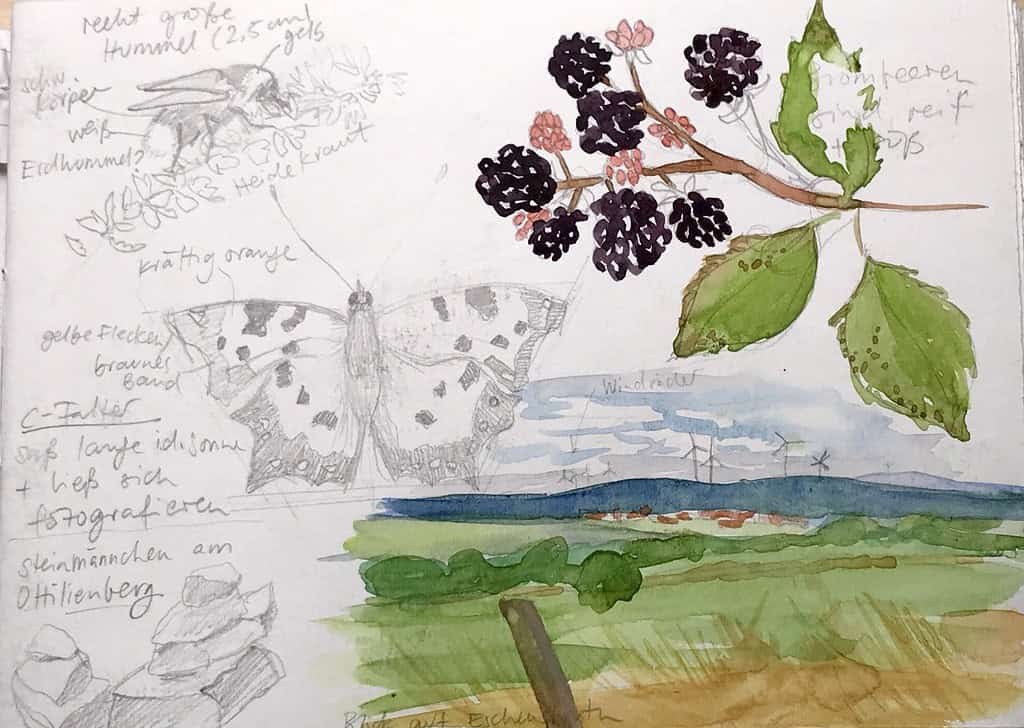
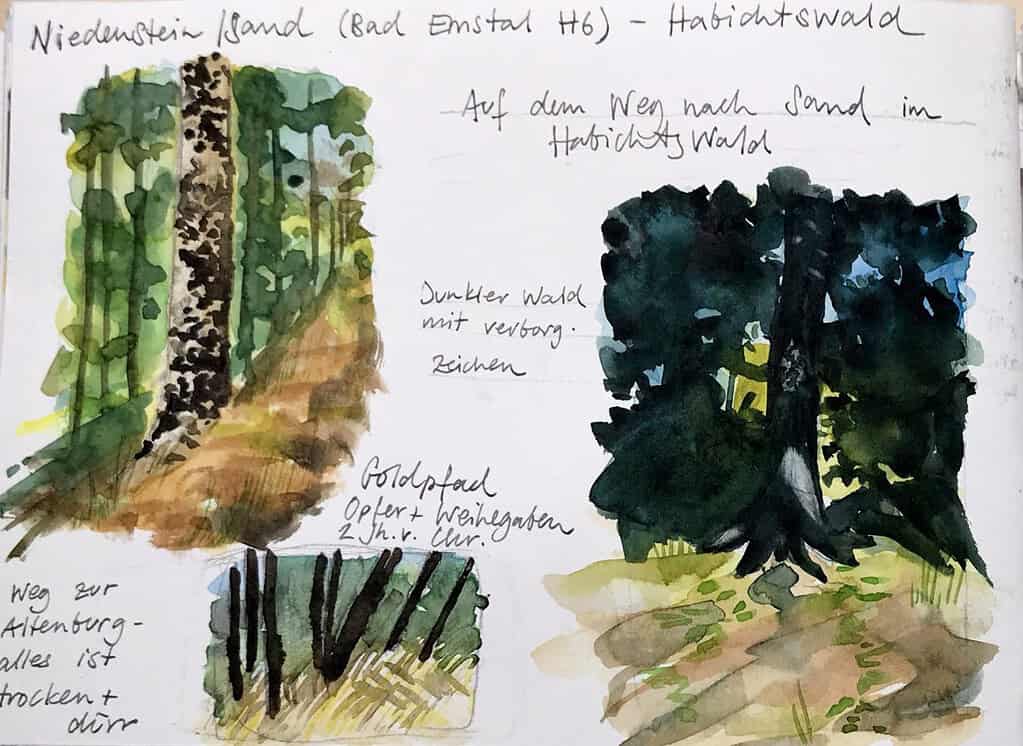
This approach can of course be modified for a longer sitting. I like to do more dedicated landscape sketches as records of how I felt about a particular place, what the atmosphere and mood was on that day. So I try to explore light and color a bit more in these small paintings and try to “sculpt” the scene a bit more. When I say paintings, they still are just sketches or impressions really, often not much bigger than the other ones, but they happen in a different sketchbook. Recently, I’ve been using gouache for most of these sketches.
Here are a few more of these sketch-paintings:
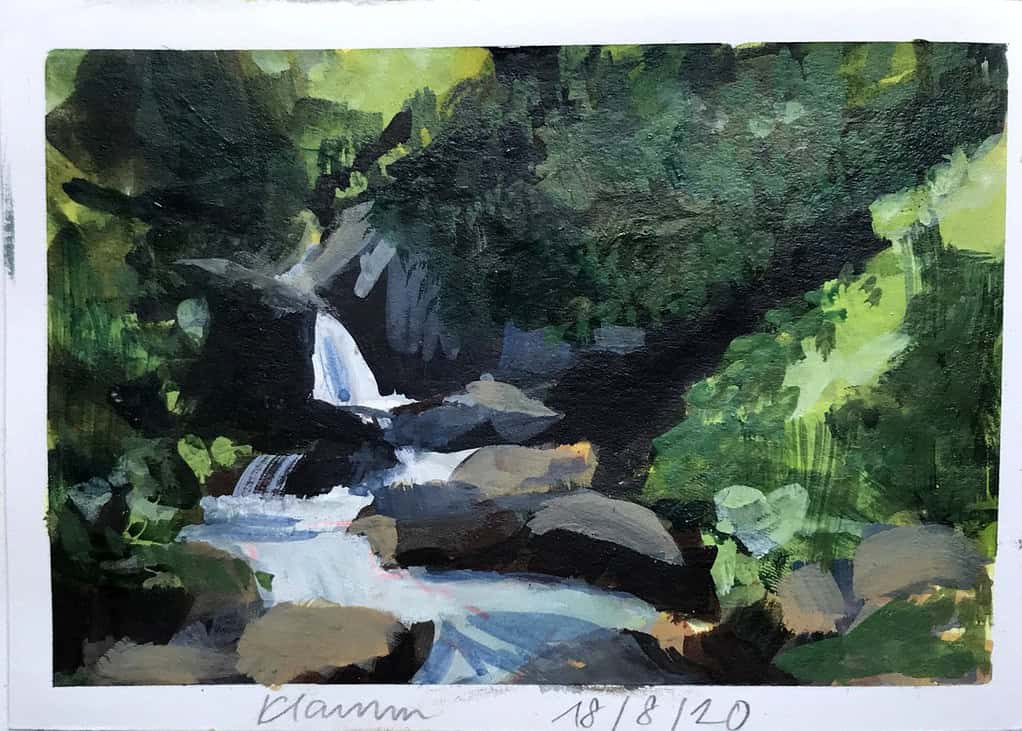
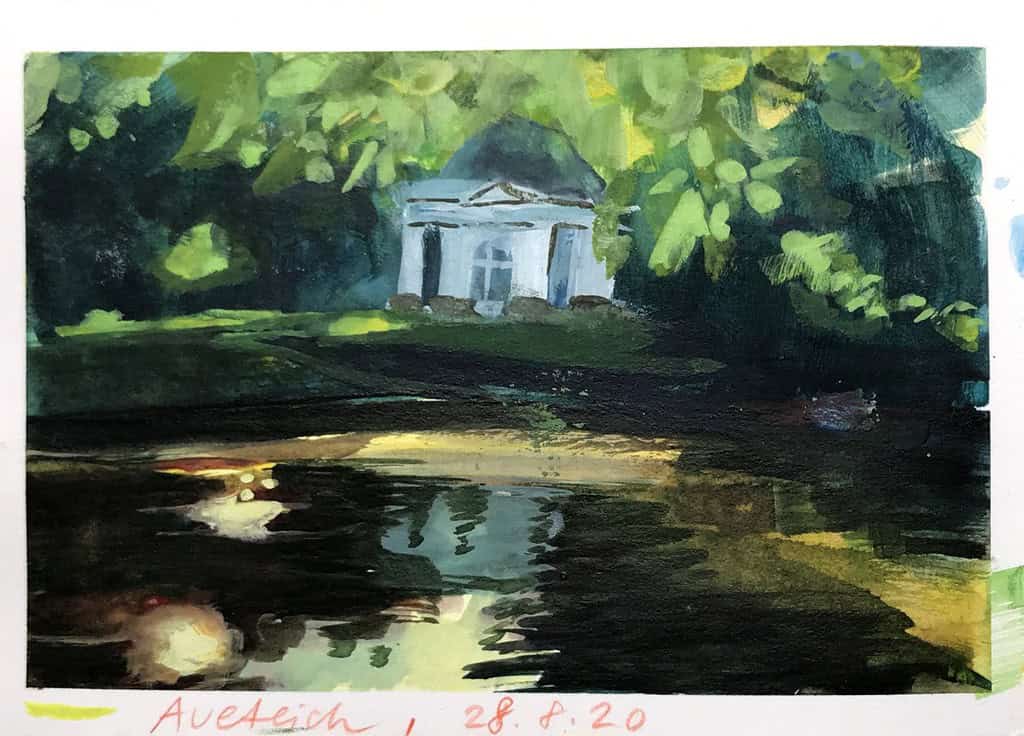
Drawing landscapes is a wonderful way to connect with a place, and spend some quiet time with the world around you. Looking at larger patterns in nature and taking in the sun, the sky and the horizon can be a very centering activity.
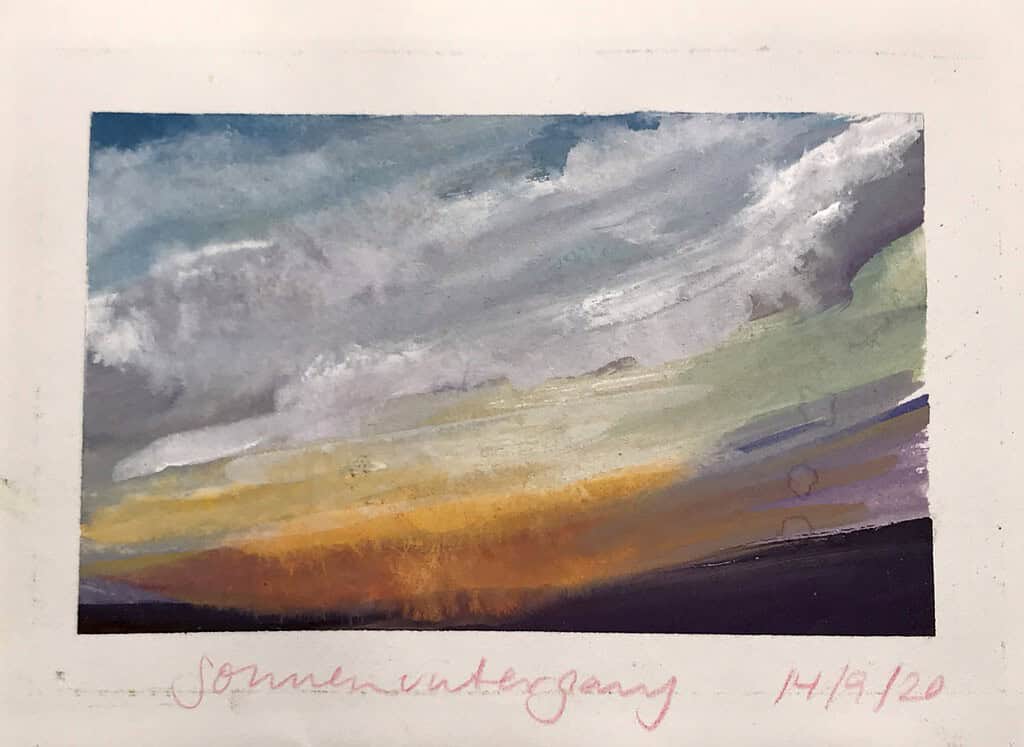
But because landscapes can be so vast, drawing them can become a bit overwhelming and a time-consuming activity. It can be confusing what to leave out and what to include, because our eyes are trained to notice contrast and details, but for quickly sketching landscapes you need to concentrate on large shapes and masses.
To record the sense of a place you don’t need more than a small study – this will be enough to show how a place feels, and connect your memories and emotions to your sketch. You will see that sketching will do a better job with this aspect than snapping a few photos – because by spending time with the landscape, you can form a connection and leave out things that aren’t necessary for your story – there are of course exceptions, like when you spend a particularly long time to compose your photograph, like a landscape photographer would do.
When you have very little time, you can still get in a quick tonal study with black ink:
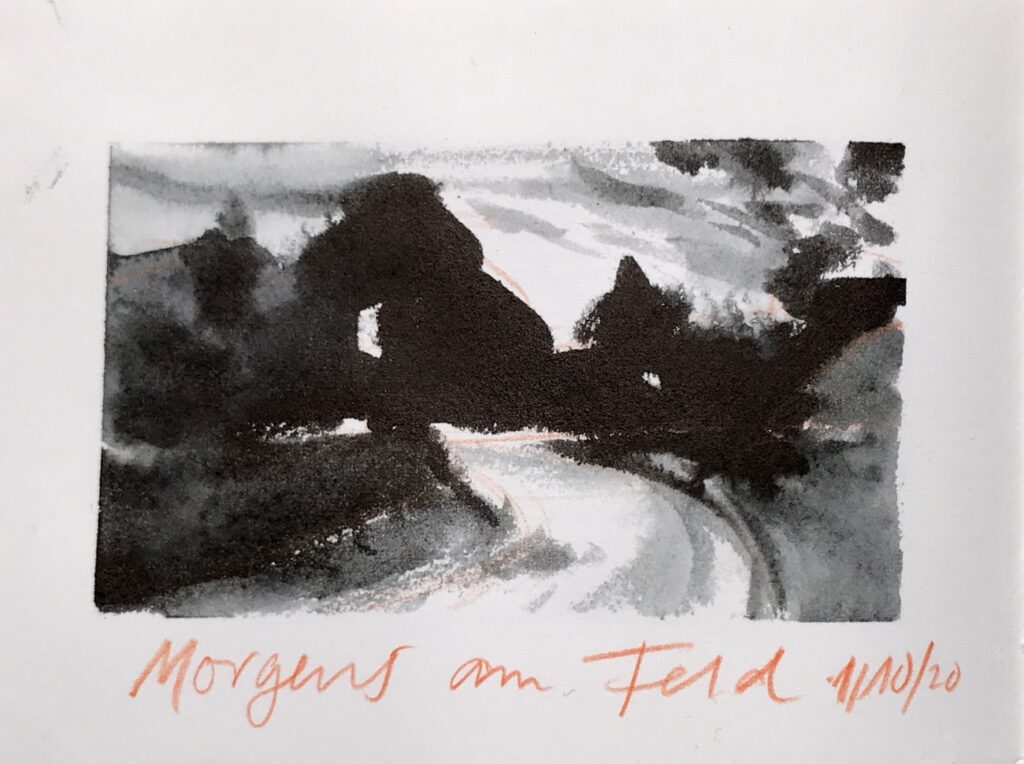
So how do I usually pick a place to start? When a part of a landscape interests me, I look for a way to frame it (sometimes with my hands or with the camera on my phone) and think about interesting compositions. The advantage of starting small is that you can see what works and what doesn’t. Tonal sketches (done in grey values) are also great, and sometimes all you need to capture a landscape is a value sketch with a bit of watercolor on top. I just draw in the major lines and elements of the composition and do the rest with watercolor.
A few practical tips:
- Don’t make your landscape thumbnail too big, you will have to spend the time with adding a lot of detail that isn’t necessary for catching the essence of a place. Thumbnails that are size of a stamp or a matchbox can be very effective.
- Keep a limited palette – one wonderful way to approach a landscape is to think about the local colors of a place and keep your palette to 3-6 basic colors. Or try 2 colors for a really limited palette. You can still mix your paints and punch in contrasts and highlights, but don’t get lost in the endless variety of tones in nature.
- Experiment. Try making a value study with only one or two colors, or change the layout to a panoramic view, or a really tall portrait frame, or only apply colors in one part of the painting. It’s your decision what you focus on.
- The rules of classical landscape painting also apply here: close objects are usually warmer, and have more detail and contrast, and receding objects (like mountains in the background) are bluer, paler and have less contrast due to the atmospheric haze – use less intense, and lighter colors when painting objects in the distance (simply dilute your paint a bit). Keeping this in mind will make your sketches more convincing.
- Natural forms are irregular – grass, trees and clouds will better when you draw them with a bit of variation. Change your brush strokes to achieve this.
- Consider the whites. If you’re using watercolor or ink, leave out the whites (clouds, glistening water, or light areas). You need to have a contrast to the darker areas, so don’t paint everywhere. With watercolor you paint the light by leaving the paper untouched. White gouache can work for some highlights too (like clouds or snowy mountain caps), and in fact, I paint most of my longer landscape sketches with white areas on top.
- Clouds are a wonderful subject but can be tricky to draw. You need to think about their shape before you lay down the blue paint for the sky. Clouds have shadows, too, and they can have a vast range of colors. Remember to make them irregular so that they don’t look like cartoon clouds. Study them when you are outside and see what kind of shapes they form.
These are the basics I think of when approaching a landscape sketch. I always try to keep it fast, fun and memorable. When you’re out hiking with someone else, you may only have a little bit of time for sketching, so use it wisely (or take a good photo and memorize what’s important for you in the scene, and paint when you’re back home – that’s what I often do these days). Instead of starting a large page-filling sketch, try to make a few quick impressionistic sketches with watercolor. On some days, or for places you know well, it may even be enough to paint a small color chart in your sketchbook.
I hope I’ve given you a few ideas on how to integrate more landscape sketching in your sketchbook. Let me know if you have more ideas or questions!


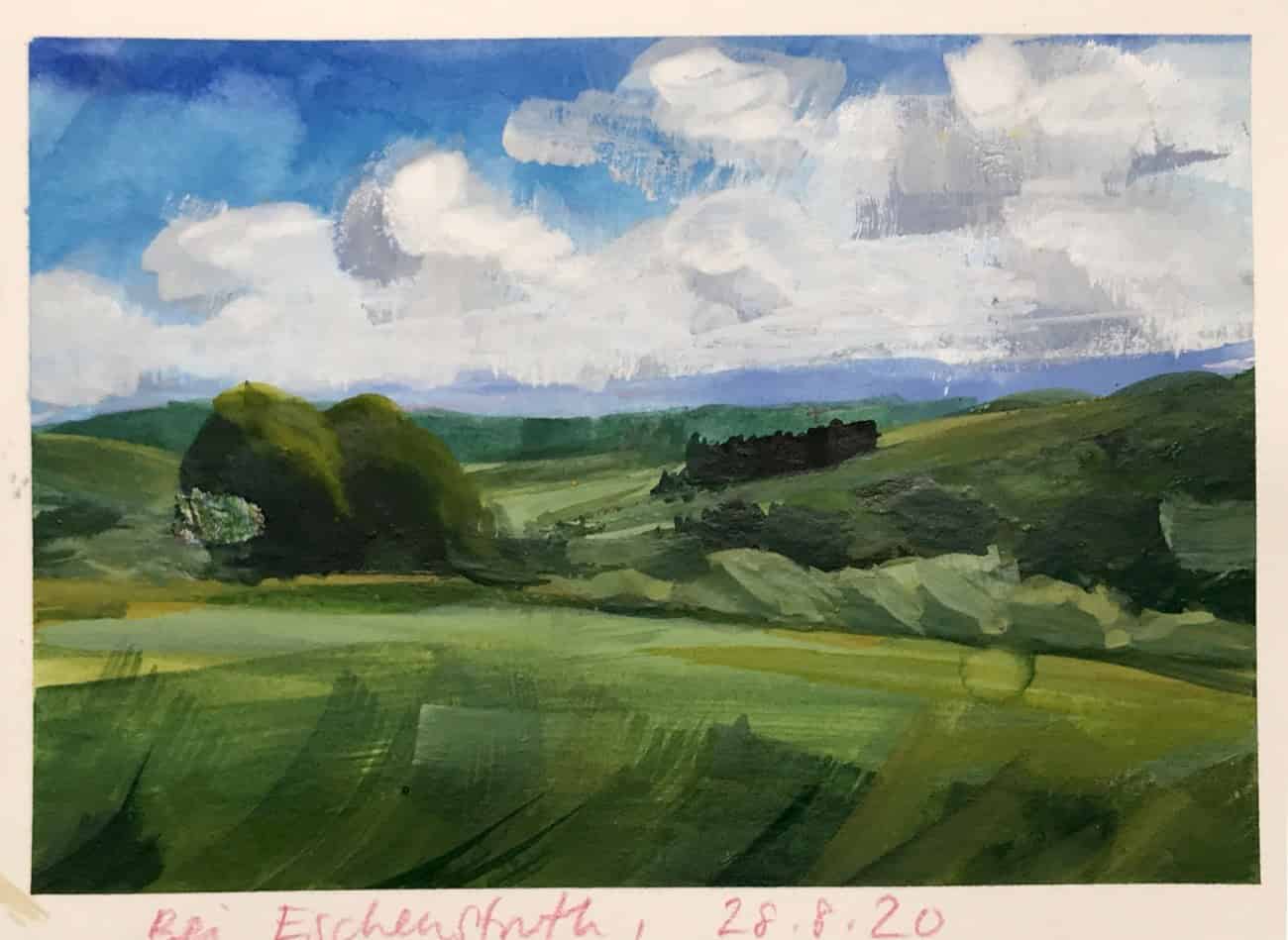

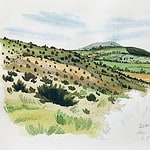
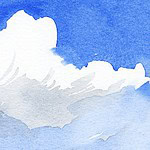
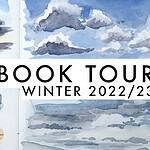
Thank you Julia
I appreciate your sensibility.
Thank you!
I love your sketches and techniques, Julia! Since I think I’m already subscribed to your newsletter, will I receive your how-to videos you list above? I would love them! Thanks so much!! —Clare Putnam
Clareputnam@Gmail.com
I’ll send you an email with the instructions, Clare!
Inspirational and terrific reminder tips.
Thank you Bill!
Your information and pages are really helpful and inspirational, Julia! I struggle with landscapes (oh, actually with all my drawing 🙂 ) because of the tendency you mention of seeing details. Seeing how you capture so much of the essence of a place in simple broad strokes and colors is wonderful. I’ll be trying out the things you suggest. Thank you so much!
You’re welcome Lisa! It is a true challenge to learn how to see for landscape sketching. Human perception naturally goes into the different direction: we see contrasts and details everywhere. And for painting, we have to unlearn that.
What a fantastic article! Succinct with wonderful experience and knowledge distilled into useful tips. Thank you so very much, Julia!
Thank you so much, Susan, I’m glad to hear that!
Julia
What a wonderful list of things to try to reset my outdoor sketching. Thanks so much.
Thank you Susan, and happy sketching!
Great overview of landscapesketching! Having a scientific background I really struggle with the simplification, since I see a lot of detail (and love detail). My best sketches are made under timepressure! Using the smallest sketchbook, 9cmx14cm, and a waterbrush also prevents me to go into too much detail. But as you write in one of your answers it is about mindset…
I know the struggle – I love detail too. Time pressure and a small sketchbook can be a huge help indeed.
Thank you Julia, for these very helpful articles. As a novice I am finding them informative and highly inspirational.
You’re welcome, Helen, and I’m happy to hear my posts are helpful!